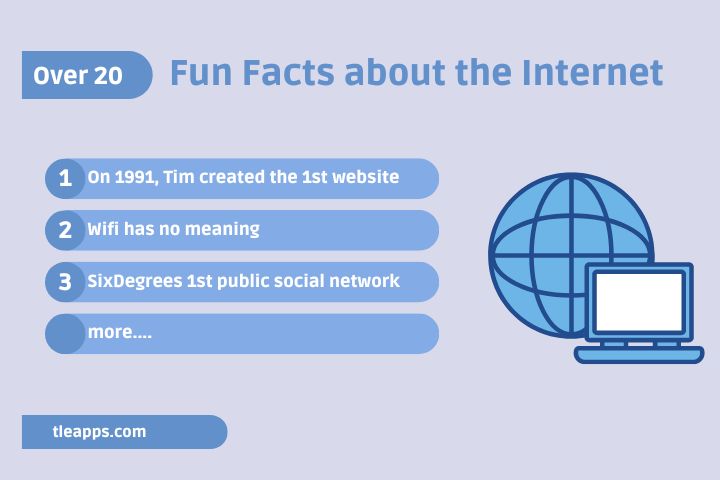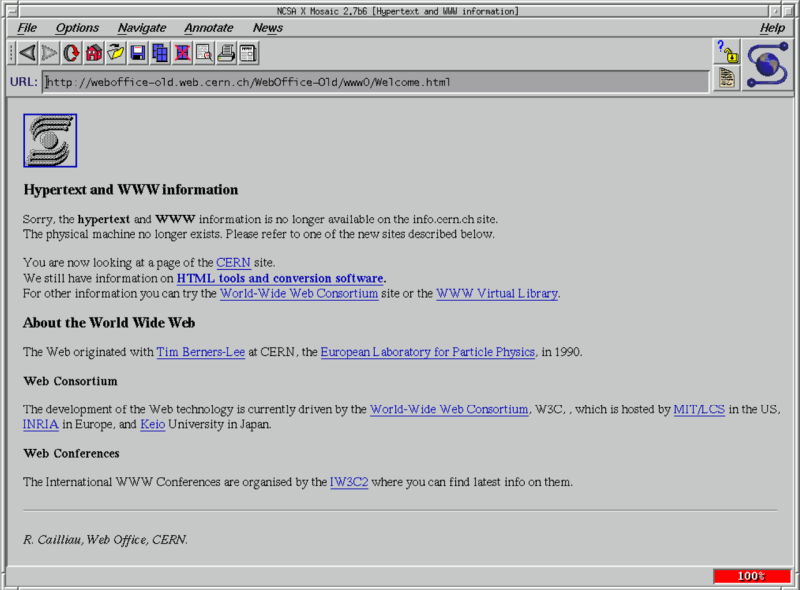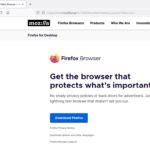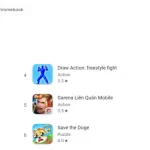The internet has come a long way since it was first created. It’s now an essential part of our lives, and we couldn’t imagine living without it. The internet has revolutionized the way we live our lives. Here are some interesting facts about this amazing technology:

Table of Contents
38 Interesting Facts About the Internet
- On August 6, 1991, Tim Berners-Lee created the first website. The website was created as part of a project at the European Organization for Nuclear Research, also known as CERN. The project was designed to allow physicists all over the world to share information. The website’s first-page address was http://info.cern.ch/hypertext/WWW/TheProject.html. This address is no longer active, but it is preserved by the World Wide Web Consortium, which was founded by Berners-Lee in 1994. The original website was very simple, consisting of only text and hyperlinks. However, it laid the foundation for the ever-growing World Wide Web that we use today.
- In 1974, the term ‘internet‘ was used for the first time to refer to a global network of computers. Forty years later, the internet has become a global phenomenon, with over two billion users worldwide. The internet has transformed how we communicate, work, and play. It has brought people closer together and given them unprecedented access to information. The internet is revolutionizing how we live and work, and it is poised to continue doing so for many years to come.
- Surfing the internet? What does that even mean? According to Jean Armor Polly, aka Net Mom, it means “browsing around without necessarily having a specific goal in mind.” And she should know – she coined the term back in 1992. In the early days of the internet, there wasn’t much to do online except look at text-based websites and maybe send an email or two. So Polly started using the term “surfing” to describe what people were doing when they traveled from site to site without any particular destination in mind. And it caught on.
- The Amazon logo is one of the most recognizable in the world. And for good reason – it’s simple, efficient, and tells you everything you need to know about the company in a single glance. The arrow connecting the letters ‘A’ and ‘Z’ indicates that Amazon carries just about everything you could need, from books to electronics to groceries.
- The first spam email was sent relatively recently, in 1978. Gary Thuerk, a marketing manager for Digital Equipment Corporation, sent an unsolicited email to 400 users of a new network called ARPANET. Thuerk was trying to generate interest in DEC’s new line of computers, but his message was quickly deemed unwelcome by the recipients. As a result, Thuerk became known as the “father of spam,” and his actions led to the development of anti-spam filters and other measures that we now take for granted.
- Mark Zuckerberg’s original Facebook profile number ID is 4. The story goes that when Zuckerberg first started Facebook in his college dorm room, all the student IDs at Harvard had numbers that ended in 1, 3, or 7. So, Zuckerberg just chose the next available number, which happened to be 4.
- The first user on Facebook is Mark Zuckerberg, the creator of Facebook. He created Facebook with a few Harvard classmates on February 4, 2004, and was the first to establish an official Facebook profile with ID #4. Many guesses were made that there were three test users, hence his ID is #4.
- As the inventor of the World Wide Web, Sir Tim Berners-Lee has had a lot of time to think about what he could have done differently. In a recent interview, he admitted that his biggest regret was the double slash // that appears in web URLs. While it may seem like a minor detail, Berners-Lee believes that it was completely unnecessary and only served to add complexity to the system.

- If you’re reading this, there’s a 64.91% chance that you’re doing so through Google Chrome. That’s because Chrome has been dominating the market for years, with a 64.91% market share as of 2022. And it’s no wonder why – Chrome is fast, reliable, and comes with a wealth of features that users love.
- In 1971, computer programmer Ray Tomlinson sent the first-ever email. The message was sent from one computer to another in the same building, and Tomlinson himself was both the sender and the receiver. While the contents of the email are now lost to history, Tomlinson’s achievement marks a major milestone in the evolution of communication.
- In the year 2000, the average human attention span was 12 seconds. By 2018, that number had dropped down to 8 seconds. The average goldfish has an attention span of 9 seconds in comparison. So what does this say about us, humans? Well, for one thing, it seems that we’ve become more easily distracted over the years. With constant access to technology and a never-ending stream of online content, it’s no wonder our attention spans have shrunk.
- In 2013, Yahoo suffered the largest data breach of all time. The birthdates, phone numbers, and security questions of around 3 billion users were stolen, leaving them vulnerable to identity theft and fraud. While no company is immune to data breaches, this incident highlights the importance of having strong security measures in place. Since the Yahoo breach, many companies have made significant changes to their security protocols, and as a result, data breaches have become less common.
- WordPress is the most hacked CMS, with 83% of hacked websites using the platform, according to documents from hack reports. While WordPress’ popularity makes it a target for hackers, its open-source nature makes it vulnerable to attack. Hackers can exploit security holes in WordPress’ code to gain access to a website’s database, making it possible to deface the site or steal sensitive information.
- In September 2019, a coordinated attack was launched against YouTube that resulted in thousands of vloggers being hacked. The majority of the targeted accounts were from the car channel community, although other content creators were also affected. The hackers gained access to the accounts by using phishing techniques to trick the users into providing their login credentials.
- Private browsing is a nice option to have when you want to keep your web history hidden from others who use your computer. However, it’s important to understand that private browsing is not as “private” as you might think. While your history may not be visible on your own computer, it remains visible to your ISP. Additionally, popular examples of private browsing modes, such as Google’s Incognito mode, only wipe visited sites on your computer – they do not provide any true anonymity. A VPN is recommended for those who want to hide their identity on the internet.
- ASCII was invented in 1963 by a computer scientist, Bob Bemer. The purpose of ASCII was to standardize the way characters were represented on computers. This allowed for uniformity across different computer platforms. ASCII is a 7-bit code, which means that 128 possible characters can be represented. These include the 26 letters of the English alphabet, numbers 0-9, and various punctuation marks.
- ASCII is still used today, though it has been largely superseded by Unicode which is a much more expansive character encoding system that can represent over 1 million different characters. That includes every character in every written language, as well as a wide variety of symbols. Unicode is the standard for character encoding on the web, and it’s what allows us to view texts in languages other than English.
- In 1965, computer scientists made history when they successfully linked two computers that were many miles apart. This was a key milestone in the development of the internet, just as the telephone and radio were key milestones in their respective technologies. The linking of these two computers allowed for the exchange of data and opened up a whole new world of possibilities.
- In 1991, a group of students at Cambridge University in England was fed up with finding an empty coffee pot every time they went to fill their cup. So, they came up with a solution: they set up a webcam and hooked it up to all the PCs in their office. This way, they could check the pot from their desks and see if it needed to be refilled. The invention of the webcam was born out of this simple need, and it has since revolutionized the way we communicate and do business.
- Microsoft Windows released its first browser, Cello, in 1993. Cello was commonly used at the Cornell Law School.
- Microsoft’s purchase of Hotmail a year after it was launched was a savvy move that helped to solidify the company’s position as a leading provider of email services. At the time of its launch, Hotmail was one of the first web-based email providers and quickly gained a large following. However, it was the merger with Microsoft that truly transformed Hotmail into the powerhouse that it is today.
- SixDegrees.com was the first public social network. It was created in 1997 and unfortunately only lasted until 1999. It enabled users to upload photos and share information, making it ahead of its time. SixDegrees.com is an important part of internet history as one of the first social networking platforms.
- 1998 was a big year for tech. It was the year that Google went live, and the world would never be the same again. Google changed the way we search for information, and its range of services has only grown since then. Today, you can use Google for email, social networking, video sharing, mapping, and cloud storage.
- In 1999, the world was introduced to the first huge online scandal. This occurred when British intelligence agents’ names were revealed without permission on an American website. This incident happened over a decade before Wikileaks became infamous. While the British government was quick to downplay the incident, it raised serious questions about the safety of online information. In the years since, we have seen a number of high-profile data breaches, each one more damaging than the last.
- The year 2000 problem, also known as the Y2K bug, the Millennium bug, the Y2K glitch, or simply Y2K, was a computer flaw that caused some computer systems to read the year 2000 as 1900. The flaw was especially common in date and time functions. As a result, many computers would have been unable to properly process dates after December 31, 1999.
- The term “wifi” is a bit of a misnomer. It isn’t short for “wireless fidelity.” And the name doesn’t tell you anything about what it is or how it works.
- When you plug an ethernet cable into your computer, you might not be thinking about the history of this technology. But the fact is, ethernet cables have a long and interesting history dating back to the early days of computer networking. The first ethernet cables were developed in 1973 for use in telecom networks. At the time, these networks were used primarily for voice communication, and the early ethernet cables were not designed for data transfer.
- It’s no secret that file sharing and media streaming are responsible for a huge amount of traffic on the web. In fact, recent studies have shown that more than half of all internet traffic is now dedicated to these activities.
- When it comes to the Internet of Things devices, ATMs are some of the oldest and most widespread. They are considered the first IoT objects.
- Facebook was originally launched as “The Facebook for Harvard University Students” on February 4, 2004. The site was created by Mark Zuckerberg, Eduardo Saverin, Andrew McCollum, and Dustin Moskovitz as a way for Harvard students to connect with one another.
- Search advertisements are the most popular type of digital advertisement today. This is because they are highly targeted and relevant to the user’s search query. When a user searches for a keyword or phrase, search ads are displayed alongside the results. These ads are usually text-based and relevant to the keyword that was searched for. Because they are so targeted and relevant, search ads tend to be very effective in getting users to click on them.
- The domain name Cars.com was purchased by a group of investors for a whopping $872 million. It was the highest price ever paid for a single domain name.
- Steve Wike invented the GIF format in 1987. He was a Compuserve engineer at the time. The format was born as a way to compress images so that they could be shared more easily online. Today, GIFs are used for everything from reaction images to educational videos. And while the pronunciation of “GIF” is a contentious issue, there’s no denying that this file format has had a major impact on internet culture.
- Emoji, the Japanese word for “image character,” has become a global phenomenon. With over 3000 symbols, including food, animals, sports, and facial expressions, people of all ages use emojis to communicate.

- Mosaic was the first web browser to gain widespread adoption. It was released in 1993 and quickly became the most popular way to navigate the nascent World Wide Web. While it remained popular for several years, Mosaic was eventually eclipsed by Netscape Navigator, which was released in 1994. Although Netscape Navigator was based on Mosaic, it included many improvements that made it more user-friendly and capable of displaying more complicated web pages.
- Napster was founded in 1999 and started as a P2P file-sharing service that allowed users to share music files. Napster quickly grew in popularity, and by 2001 it had millions of users.
- RSS ( Really Simple Syndication) is a technology that many people use every day without even realizing it. Every time you see a social media feed full of updates from your friends or news from your favorite website, RSS is what’s responsible.
- It’s hard to believe that it has been over 25 years since the launch of Internet Explorer. At the time, it was a game-changing browser that ushered in a new era of online exploration. Today, IE is a fond memory for many people who have moved on to other browsers. But it’s important to remember the role that IE played in the early days of the internet. For many people, IE was their first introduction to the world wide web.
Quick Facts about the Internet
- The first website ever created was http://info.cern.ch/.
- The first person to purchase something on the internet was a man, who bought a Sting CD in 1994.
- The first.com domain name ever registered was Symbolics.com in 1985.
- The first Google search engine query was “What is love?”
- Netflix was founded in 1997, which is longer than Google has been around.
- Amazon was founded in 1994 by Jeff Bezos, who started the company out of his garage!
- eBay was founded in 1995 by Pierre Omidyar, who started the company as a side project while working at a consulting company.
- The longest domain name registered is beatles.com, which has 60 characters in it!
- The first recorded use of the @ symbol was by businessman Francesco Lapi in 1536, when he used it to sign his last name “Lapi.”
- China has specialized clinics for Internet addiction.
- The security of your website is a top concern for most business owners, but the reality is that 30 thousand websites get hacked every day. With constant threats from cybercriminals and state-sponsored hackers alike it’s more important than ever to have an up kept online presence in order to protect yourself as well as others who may rely on these resources like customers or employees!
- Imagine reaching the height of Mt. Everest and finding that you are not alone in the world anymore; there’s high-speed Internet up here too!
- The majority of internet traffic is not humans. The bots and malware generate most of the traffic.
- In 2015, the internet came back hard on a U.S journalist who posted an article link online and got five years in prison for it!
- Internet addiction is something that many people debate. Some say it’s a motivating factor in some crimes, while others feel there isn’t enough evidence to label this behavior with an official disorder and instead view Internet usage as just one more thing you can control for yourself – like your diet or exercise routine!
- The first webcam was created in Cambridge to check the status of a coffee pot. Fortunately for all you aspiring hackers out there, this is just one small example that your applications can go places and do things never thought possible before!
- The web is a vast and ever-changing place, with over 100 thousand new dot com domains being registered every day.
- Internet trolls are a fascinating and strange breed. They have been found to be “narcissistic, psychopathic, sadistic” and even bladed!
- I don’t know about you, but I’m hooked. With 50% of internet users quitting their browser after 10 seconds and most people only spending 2 minutes on any given page before moving onto another site or app – this is an issue that needs solving!
- While many people in China still use traditional desktop computers, there are more mobile internet users than regular landline or laptop ones.
- The number of emails we receive in a day is staggering and, according to 70%, spam.
- It’s no wonder that at the end of 1993 there were only 623 websites on this new internet thing! How many are we up to now?! It’s a little hard for me sometimes when I think about how much information has been added since then!
- When the Internet came along, it turned out that “LOL” meant a whole lot more than just laughing all day. It meant “lots of love”.
- Finland is a country that has always been at the forefront of new ideas and innovations. In 2010, they took it one step further by making Internet access legal for all citizens!
- The seven people who have access to the keys that can restart our world wide web in case of an emergency are just waiting for their chance.
- You can’t go wrong with a book that’s been on Amazon since July 1995. Fluid Concepts and Creative Analogies was the 1st book sold on Amazon. It is an essential read for anyone who has ever felt like they don’t quite belong in this world, or wanted to know what it would be like if their life had another ending–as long as you’re willing to accept something less than perfect.
- Marques Johnson, Snapchat’s creator, had tried over thirty projects before launching the social network that eventually became one of today’s most popular applications.
- There were 13 employees in the Instagram company when Facebook acquired it for $1 billion.
- The Internet in 1973 was a small network of 42 computers.





